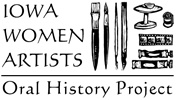About the Project
general | activities | creator/director | the interviews | project logo
general information
The Iowa Women Artists Oral History Project began in the first half of 1998. Names for the original mailing were gathered from several sources, including the Iowa Arts Council artists' directory, recommendations from artist friends and relatives, lists from galleries, and art exhibits. This letter, sent to over 100 women, stated general criteria for the interviewees, namely women visual artists:
- who are age 30 or older,
- who had lived in Iowa for at least the past five years (or who previously lived in Iowa for several years and recently returned), and
- who consider art their major activity or vocation (including the teaching of art).
As the interviewing progressed, many of the artists also suggested more names, which resulted in further mailings. While the initial hope was to interview nearly all women visual artists in Iowa, it quickly became clear that this would be impossible—even limiting the types of artwork included. Although many more artists live and work all across Iowa, the interviews ended with 79. Two artists later withdrew from the project after receiving a copy of their transcript. (Also, one who moved out of state later asked that her name be withdrawn from this website, although her interview remains in the Iowa Women's Archives.)
Those interviewed represent a fair cross-section of artwork, location, and age, but regrettably racial and ethnic diversity is limited. Some of this is inherent in the makeup of Iowa's population; some is due to interviewee self-selection (not responding to or declining the invitation to participate); some is due to the Project's limited resources, time, and ability to locate artists. Hopefully, the work of identifying and preserving the work and lives of women artists in Iowa will continue and grow beyond this Project. The Project is not currently interviewing additional artists.
activities
- interviews with 79 artists, mid-1998 to September 1999
- web site up, mid-1999
- transcription completed, November 1999
- production of three audio or audiovisual presentations
- delivery of tapes and transcripts to the Iowa Women's Archives, November 2001
- production of desktop calendars featuring interview quotes, 2000-2004
- creating first-person narratives
- featured segment on Iowa Public Television's "Living in Iowa" show, January & June 2002
- Midday Show on WOI-AM Radio, January 2002
- featured article in Des Moines Register, February 2002
- ten-year updates on artists, 2008
- revamped website, 2012-13
the interviews
The interviews cover family and personal history (childhood through the present), education, development as an artist, artwork, creative process, influences, and more. They vary in length, but on average are one-and-one-half hours. The interviews were recorded on Maxell Type II audiotapes, using a portable Marantz stereo cassette recorder and two lapel cardiod microphones. The interviews usually took place in the artist's home or studio. The interviewer, Jane Robinette, traveled over 5,800 miles to 33 towns and cities, collecting 79 interviews on 148 tapes, resulting in 1,830 transcript pages.
project logo
The Project logo graphic was created by using and arranging several different Art Parts clipart pieces. To see more Art Parts, visit the Art Parts website. Thanks to the friendly creators of Art Parts, Ron and Joe.
